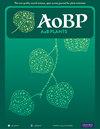Acquisition of green algal photobionts enables both chlorolichens and chloro-cyanolichens to activate photosynthesis at low humidity without liquid water
IF 2.4
3区 生物学
Q2 ECOLOGY
引用次数: 0
Abstract
Background and Aims Cyanobacteria require liquid water for photosynthesis, whereas green algae can photosynthesise with water vapour alone. We discovered that several Lobaria spp. which normally have cyanobacteria as the sole photobiont, in some regions of the trans-Himalayas also harboured green algae. We tested whether green algal acquisition was: limited to high elevations; obtained from neighbouring chloro-Lobaria species; enabled photosynthesis at low humidity. Methods Lobaria spp. were collected from 2000 – 4000 m elevation. Spectrophotometry quantified green algal abundance by measuring chlorophyll b (absent in cyanobacteria). Thalli cross-sections visually confirmed green algal presence. We sequenced gene regions: Lobaria (ITS-EF-1α-RPB2), green algae (18S-RBC-L) and Nostoc (16S). Phylogenetic analysis determined myco-photobiont associations. We used a custom closed-circuit gas exchange system with an infrared gas analyzer to measure CO2 exchange rates for desiccated specimens at 33%, 76%, 86% and 98% humidity. Key results Cross-sections revealed that the photobiont layers in putative cyano-Lobaria contained both cyanobacteria and green algae, indicating that they should be considered chloro-cyanolichens. Chloro-Lobaria had no visible cephalodia nor cyanobacteria in the photobiont layer. Chloro-Lobaria and chloro-cyano-Lobaria had comparable levels of chlorophyll b. Chloro-Lobaria usually contained Symbiochloris. Chloro-cyano-Lobaria mainly associated with Parachloroidium and Nostoc; infrequently with Symbiochloris, Apatococcus, Chloroidium, Pseudochlorella, Trebouxia. Sequences from two green algal genera were obtained from within some thalli. Desiccated specimens of every Lobaria species could attain net photosynthesis with light exposure and 33% humidity. CO2 exchange dynamics over a five-day period differed between species. Conclusions At all elevations, chloro-cyano-Lobaria spp. had abundant green algae in the photobiont layer, but green algal strains mostly differed to those of chloro-Lobaria spp. Both chloro-Lobaria and chloro-cyano-Lobaria were capable of conducting photosynthesis without liquid water. The data strongly suggest that they attained positive net photosynthesis.获取绿色藻类的光附生体使叶绿藻和叶绿青藻能够在低湿度条件下启动光合作用,而无需液态水
背景与目的 蓝藻需要液态水进行光合作用,而绿藻只需水蒸气即可进行光合作用。我们发现,在跨喜马拉雅山的一些地区,通常以蓝藻为唯一光生寄主的几种Lobaria属植物也生长着绿藻。我们测试了绿藻的获取是否:仅限于高海拔地区;是否从邻近的绿叶植物中获取;是否能在低湿度条件下进行光合作用。方法 从海拔 2000 - 4000 米处采集龙舌兰属植物。分光光度法通过测量叶绿素 b(蓝藻中没有)来量化绿藻的丰度。藻体横切面可目测确认绿藻的存在。我们对基因区域进行了测序:Lobaria (ITS-EF-1α-RPB2)、绿藻 (18S-RBC-L) 和 Nostoc (16S)。系统发育分析确定了藻类与光生物的关联。我们使用定制的闭路气体交换系统和红外气体分析仪来测量干燥标本在 33%、76%、86% 和 98% 湿度下的二氧化碳交换率。主要结果 横截面显示,假定的蓝藻中的光生菌体层包含蓝藻和绿藻,这表明它们应被视为绿藻。绿球藻的光生菌体层中没有可见的头状菌和蓝藻。叶绿藻和氯蓝藻的叶绿素 b 含量相当。氯青绿藻主要与 Parachloroidium 和 Nostoc 相关,很少与 Symbiochloris、Apatococcus、Chloroidium、Pseudochlorella 和 Trebouxia 相关。从一些藻体中获得了两个绿藻属的序列。在光照和 33% 的湿度条件下,每个 Lobaria 种类的干燥标本都能进行净光合作用。不同物种在五天内的二氧化碳交换动态有所不同。结论 在所有海拔高度,氯青苔属植物的光生植物层中都有丰富的绿藻,但绿藻菌株大多与氯青苔属植物不同。数据有力地表明,它们实现了正净光合作用。
本文章由计算机程序翻译,如有差异,请以英文原文为准。
求助全文
约1分钟内获得全文
求助全文
来源期刊

AoB Plants
PLANT SCIENCES-
CiteScore
4.80
自引率
0.00%
发文量
54
审稿时长
20 weeks
期刊介绍:
AoB PLANTS is an open-access, online journal that has been publishing peer-reviewed articles since 2010, with an emphasis on all aspects of environmental and evolutionary plant biology. Published by Oxford University Press, this journal is dedicated to rapid publication of research articles, reviews, commentaries and short communications. The taxonomic scope of the journal spans the full gamut of vascular and non-vascular plants, as well as other taxa that impact these organisms. AoB PLANTS provides a fast-track pathway for publishing high-quality research in an open-access environment, where papers are available online to anyone, anywhere free of charge.
 求助内容:
求助内容: 应助结果提醒方式:
应助结果提醒方式:


